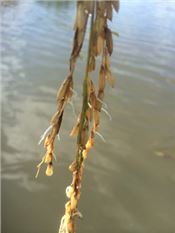|
Historic August Flooding Will Cost Louisiana Agriculture At Least $110 Million

If rice has sprouted in the field, it needs to be harvested as soon as possible
and sent to the drier. Typically, this rice will be discounted for water damage and stain.
Photo by Ken Lyon near Roberts Cove in Acadia Parish
BATON ROUGE, LA.
Heavy rains that recently caused historic flooding in south Louisiana will cost the state’s agriculture industry at least $110 million, according to preliminary estimates from the LSU AgCenter.
That figure is expected to grow as farmers realize the full extent of flood damage, said AgCenter economist Kurt Guidry. Many factors – including crop yield and quality reductions, increased production costs, infrastructure damage and loss of stored commodities – are not immediately clear. And daily rains that are typical of summer weather patterns could slow the fall of floodwaters, delay harvest and cause even more damage to crops and animals.
The soybean crop will likely take the hardest hit, with about $46 million in yield losses expected. Very little of the 420,000 acres of soybeans in affected areas had been harvested before the flood, Guidry said.
“This is particularly true in the sugarcane-growing region, where soybeans were ready to be harvested at the time of flooding,” he said. “Many of those acres that flooded will experience nearly 100 percent losses.”
Yield reductions will cost the Louisiana rice industry about $33 million. Much of the south Louisiana crop was already harvested, but about 20 percent, or 72,000 acres, remained in the field during the flood.
Those fields may be a total loss, and any rice that is harvested will likely sell for lower prices because of sprouting and reduced milling quality, Guidry said. Farmers may not be able to produce a ratoon, or second, crop, he said.
At least $3 million worth of sugarcane will have to be replanted, Guidry said. About 15 percent of the 100,000 to 120,000 acres that is planted every August and September was planted before the flood, he said. Poor field conditions may delay or prohibit planting the rest of those acres before harvest season.
“Once harvest begins, producers do not have the labor or resources to both plant and harvest at the same time,” Guidry said. “This could cause some acres to not be planted. This has a tremendous multiplier effect due to sugarcane’s multiyear production cycle.”
Corn-producing areas did not receive heavy flooding damage, although wet field conditions have delayed harvest, which can cause plants to fall over and grains to sprout, Guidry said. Those issues could cost corn farmers $10 million.
Other crops, including vegetables, fruits, sweet potatoes, cotton and grain sorghum, also received some flood damage.
It is not yet clear how many livestock deaths the flood caused. Reduced pasture resources and forage availability will cost producers nearly $2 million, Guidry said.
The AgCenter will release a more detailed assessment on the flood’s damage to farming within a few weeks.
“Weather conditions over the next several weeks will be highly influential of the exact nature of the impacts for several commodities,” Guidry said. “Better conditions, mostly in terms of dry conditions, could help many of these crops rebound and certainly would allow for timelier harvest and limit production and quality issues." ∆
|
|